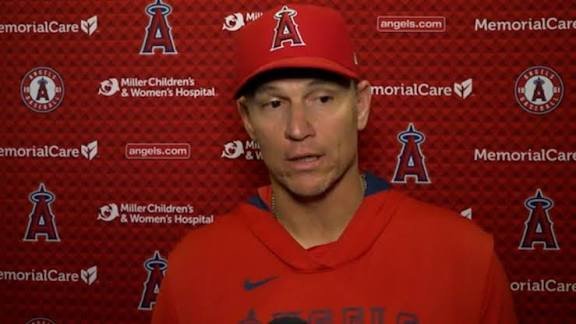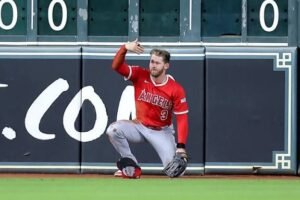
Introduction

Joseph Taylor Ward, born December 14, 1993, is a professional baseball outfielder known for his powerful bat and patient plate discipline. Over the years, he’s become a key offensive piece — but his journey to stardom has been shaped by injuries, analytical breakout, and shifting trade dynamics. In this article, we explore his trade history, injury timeline, advanced metrics (via Fangraphs and Baseball Savant), his age and development trajectory, and statistical highlights.
Early Life and Career Beginnings
Taylor Ward was born in Dayton, Ohio. He played college baseball at Fresno State University. In the 2015 MLB Draft, he was selected by the Los Angeles Angels in the first round (26th overall).
He made his major league debut on August 14, 2018, at the age of 24. Initially, he didn’t have a full-time role, but over time, he grew into a more regular presence.
Age and Development
As of 2025, Ward is 31 years old (born December 14, 1993). At 6′0″ and 200 lbs, he has a strong build which helps his power profile.
His development trajectory has been gradual but steady. Early on, he played multiple positions (catcher, third base) in the minors before transitioning to the outfield full-time, which helped unlock his offensive potential.
Ward himself has spoken about improving his bat speed over time, noting that increased bat speed can make a big difference in converting hard-hit balls into extra-base hits.
Injury History
Taylor Ward’s career has not been without setbacks. Below are some of the notable injuries and incidents:
-
2023 — Facial Fractures
-
On July 28, 2023, Ward was hit in the face by a pitch from Alek Manoah.
-
He suffered multiple facial fractures and was placed on the 60-day injured list.
-
He underwent reconstructive surgery; multiple plates (including in his face and skull) were inserted.
-
-
2025 — Collision with Wall
-
In August 2025, Ward collided face-first with a metal scoreboard while chasing a liner, leading to a cut above his eye.
-
He was carted off the field and taken to hospital for evaluation.
-
-
Other Injuries
-
According to transaction/injury logs, he has had day-to-day issues like knee injury and back tightness.
-
Despite these injuries, Ward has shown resilience, bouncing back with strong offensive seasons.
Trade Value and Recent Trade News
Recent Trade (2025)
A major career moment came in November 2025, when Ward was traded:
-
The Baltimore Orioles acquired Taylor Ward from the Los Angeles Angels in exchange for right-handed pitcher Grayson Rodríguez.
-
Rodríguez, a young pitcher, was recovering from an elbow injury.
-
From the Angels’ perspective, trading Ward made sense because he was approaching free agency and had strong trade value, especially after a career-best 2025.
This trade reflects how Ward’s veteran bat and power are valuable assets, but also that his age and contract status make him a logical trade piece for a team looking to bolster its lineup or free up payroll.
Trade Speculation and Interest
Even before the trade, Ward had drawn trade interest from other teams. For example, there were analyses suggesting teams like the Philadelphia Phillies could target him.
His steady power, combined with his patient plate approach and solid counting stats (home runs, walks), made him an attractive candidate for teams that needed a reliable middle-of-order bat.
Advanced Metrics: Fangraphs & fWAR
While detailed FanGraphs (Fangraphs) data for every year is not public here, Ward’s performance can be contextualized with sabermetric insights quoted by analysts and metrics derived from his profile.
-
According to Yardbarker, in 2025 Ward posted 2.9 fWAR, one of his highest marks, reflecting strong offensive value.
-
His wRC+ in 2025 was also impressive — in context, a wRC+ well above 100 signals that he is an above-average run producer.
-
His walk rate in 2025 was 11.3%, showing excellent plate discipline.
-
On the other hand, his strikeout rate was high (~26.4% in 2025), which is a trade-off for his power.
His underlying metrics (exit velocity, expected slugging) also paint a strong picture:
-
According to Pitcher List’s data, Ward’s xAVG (expected batting average) was .234 in 2025, and xwOBA (expected weighted on-base average) was .339.
-
These metrics suggest that even when outcomes might not always reflect it, his contact quality was very good — he was making strong contact, generating good quality batted balls.
From retrospective analyses (like those in 2022), Ward was compared to Mike Trout in terms of approach: selective swing decisions, not chasing pitches out of the zone, and a balanced swing.
Baseball Savant Metrics
Using Baseball Savant and Statcast-related data (as reported by media and analysts):
-
In his breakout phase, Ward showed strong barrel rate — the percentage of batted balls with optimal combination of exit velocity and launch angle. According to MLB’s analysis, at one point he was barreling 15.5% of his batted balls, putting him in very high percentiles.
-
His xSLG (expected slugging) was very high, indicating that even his non-home run batted balls had a lot of power potential.
-
In terms of swing-take profile, Ward’s chase rate (swinging at pitches outside the strike zone) was very disciplined — again, a parallel to Mike Trout’s approach.
-
His run value by region of the strike zone (how valuable his swings were in different parts of the strike zone) indicated he was strong not just in the “heart” of the zone but also edges — meaning he could handle various pitch locations effectively.
These Savant-style metrics underscore that Ward’s offensive output is not just raw power: it is backed by elite contact quality, disciplined pitch selection, and advanced batted-ball skills.
Traditional Stats & Milestones
Here’s a breakdown of Ward’s key traditional statistics and career milestones:
-
In the 2025 season, Ward had 579 at-bats, a batting average of .228, 36 home runs, 103 RBIs, 4 stolen bases, and an OPS of .792.
-
Over his career (as of 2025), Ward has:
-
2494 at-bats
-
113 home runs
-
A slash line of .247 / .327 / .439 (BA / OBP / SLG).
-
-
According to his Baseball-Reference profile, his career WAR (Baseball-Reference) is ~9.9.
-
He has had multiple 20+ home run seasons (2022, 2024, 2025) and in 2025, he crossed 30 home runs for the first time.
-
He also notched his first 100+ RBI season in 2025.
Trade Implications and Future Outlook
Why the trade happened (2025):
-
The Angels likely traded Ward because of his high trade value and his contract situation (approaching free agency).
-
From the Orioles’ (or acquiring team’s) perspective, they gained a proven middle-of-lineup bat for a controllable young pitcher.
Risks and rewards:
-
Reward: Ward brings power, walks, and sabermetric upside. His advanced metrics suggest he can produce efficiently.
-
Risk: Injuries (particularly his facial injuries) and age (entering his early 30s) could limit long-term value.
Outlook:
-
If healthy, Ward could continue to be a high-leverage offensive piece for whichever team acquires him.
-
Given his skill set, it’s likely that he will remain a valuable bat in the next few seasons — especially in a league that values power and on-base skills.
-
Teams might also explore contract extensions, depending on his health and production.
FAQs
Q1: What is Taylor Ward’s age and contract status?
-
As of 2025, Taylor Ward is 31 years old (born December 14, 1993).
-
He was traded in November 2025, and part of the trade calculus was that he was nearing free agency, making him an attractive trade asset.
Q2: What injuries has Taylor Ward had?
-
He suffered multiple facial fractures in 2023 after being hit by a pitch and required reconstructive surgery with plates.
-
In 2025, he collided with a metal scoreboard, cutting his face and being escorted off the field.
-
He has also had day-to-day injuries such as knee discomfort and lower back tightness.
Q3: What do his advanced metrics (Fangraphs / Savant) say about him?
-
His fWAR (FanGraphs WAR) in 2025 was reported around 2.9, indicating significant value.
-
He has strong xwOBA (.339) and xAVG (.234), showing good quality of contact.
-
His barrel rate, exit velocity, and swing discipline are all very strong, placing him among well-regarded hitters in terms of batted-ball quality.
Q4: Why was Taylor Ward traded?
-
In November 2025, the Orioles acquired Ward from the Angels in exchange for Grayson Rodríguez, a young pitcher.
-
The trade likely reflects a balance: the Angels capitalized on his value ahead of free agency, while the acquiring team gained a proven power bat.
Q5: What are Taylor Ward’s career stats?
-
As of 2025: ~.247 batting average, 113 home runs, 345 RBIs, .327 OBP, .439 SLG, ~9.9 career WAR (BR).
-
His 2025 season alone: 36 homers, 103 RBIs, .228 AVG, .792 OPS.
Conclusion
Taylor Ward’s journey in MLB illustrates the evolution of a role player into a frontline bat. Despite serious injuries, he has demonstrated resilience and steady improvement. His advanced metrics (from Fangraphs and Baseball Savant) highlight his high-quality contact, disciplined approach, and power potential. The trade in 2025 underscores his value: a respected veteran bat coveted by teams willing to pay for immediate offensive production. As he enters the next chapter of his career, health and consistency will be key—but his profile suggests he still has a meaningful impact ahead.

Leave a Reply